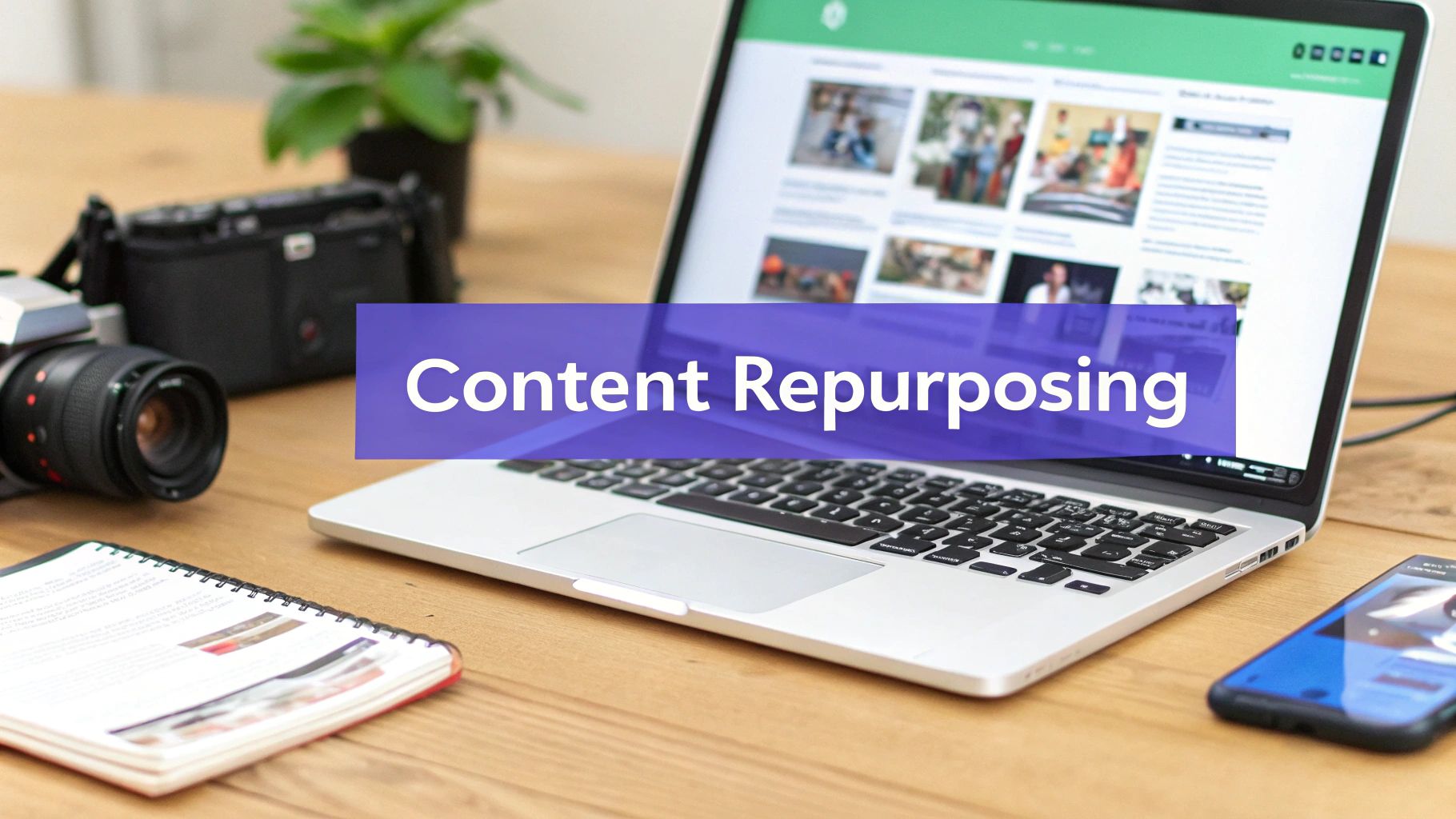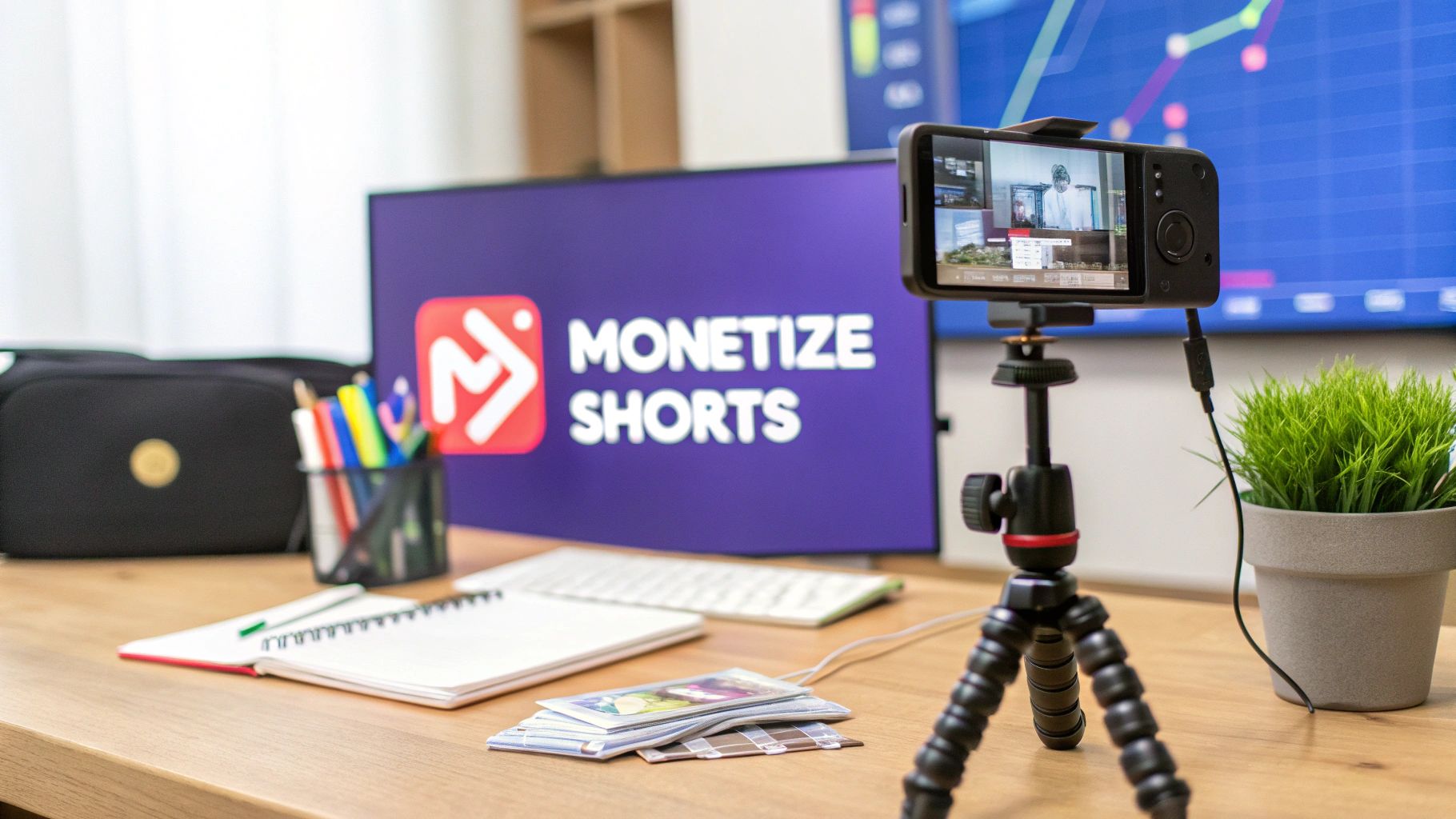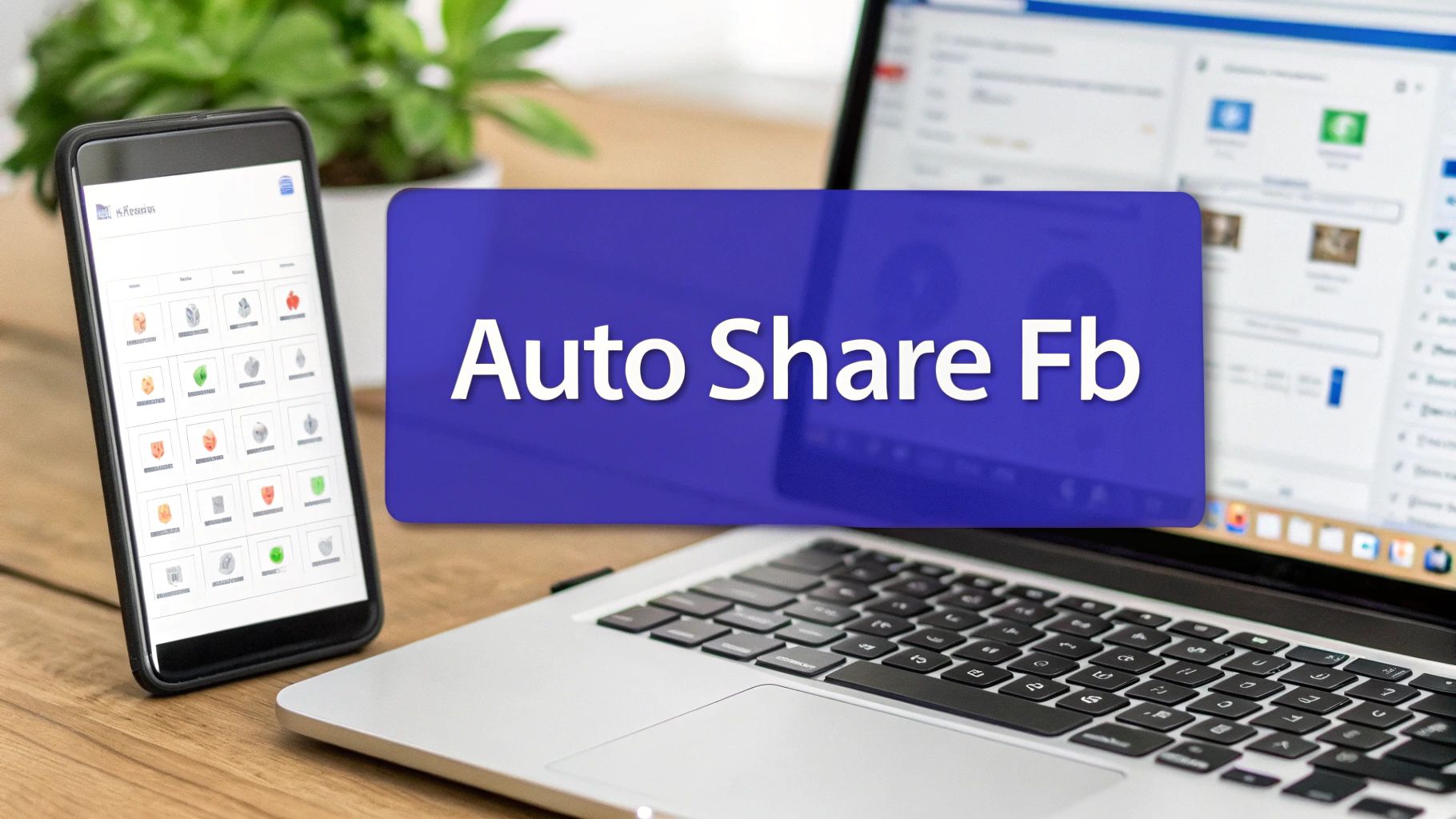Creating high-quality content is only half the battle. The other half involves ensuring it reaches the widest possible audience and delivers maximum impact. This is where the strategic practice of repurposing content for social media becomes a game-changer for marketers, creators, and brands alike. Instead of constantly brainstorming new ideas, you can intelligently transform a single pillar piece, such as a blog post, webinar, or podcast, into dozens of tailored assets for platforms like Instagram, TikTok, and LinkedIn.
This approach saves significant time and resources while reinforcing your core message across channels. By adapting one strong asset, you build brand consistency and boost engagement without starting from scratch. It is the key to maintaining a full content calendar while avoiding creative burnout.
In this guide, we will move beyond generic advice to explore seven proven, actionable methods for repurposing content for social media. You will discover the specific strategies, tools, and real-world examples needed to work smarter, not harder. By the end, you'll have a clear roadmap to amplify your best work, keep your platforms active, and drive meaningful results.
1. Atomization Strategy
The atomization strategy is the cornerstone of effective content repurposing for social media. It involves systematically deconstructing a single, substantial piece of long-form content, often called a "pillar" or "hero" piece, into numerous smaller, distinct assets tailored for various social media platforms. This approach allows you to maximize the reach and impact of your most valuable content, creating multiple audience touchpoints from a single investment.
Think of a comprehensive webinar or an in-depth blog post as a large block of marble. Atomization is the art of carving that marble into several unique sculptures, each appealing to a different audience segment on a different platform. This method transforms one major content effort into a cascade of social media posts, ensuring your core message is seen and absorbed across the digital landscape.
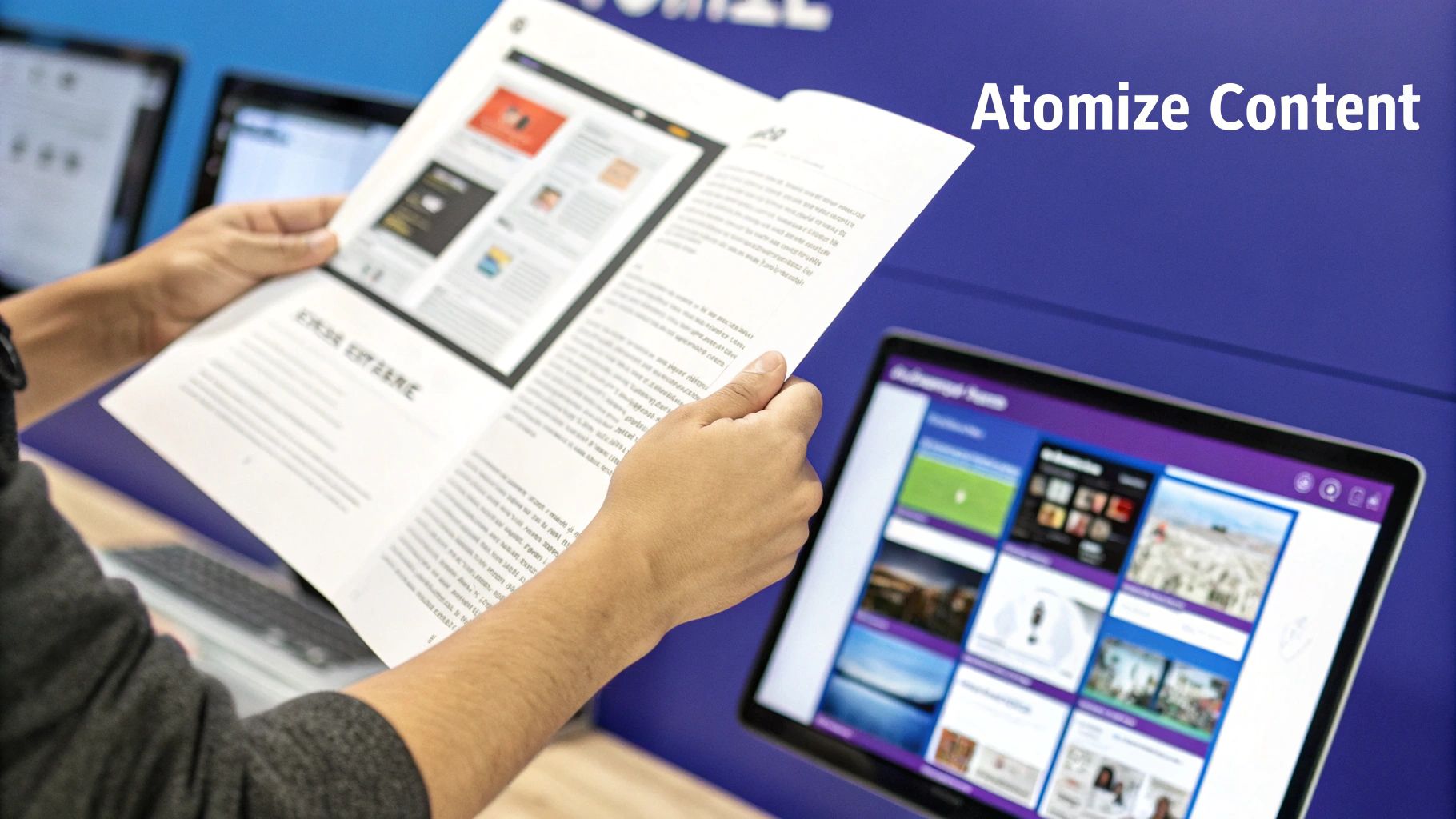
How to Implement Content Atomization
Successfully breaking down content requires a structured plan. The goal isn't just to chop up content randomly but to extract specific, valuable ideas and reframe them for each channel's native format.
- Pillar Content: Start with a high-value, comprehensive piece like a webinar, a detailed guide, a podcast episode, or a research report.
- Key Takeaways: Identify the most powerful statistics, quotes, concepts, and actionable tips within the pillar content.
- Platform-Specific Assets: Convert these takeaways into formats best suited for each social network. For example:
- Twitter/X: Transform key statistics into a text-based tweet or create a thread expanding on a core concept.
- Instagram: Design a visually appealing carousel highlighting 5-7 key steps from a guide. Turn a powerful quote into a branded graphic for the feed or a Reel.
- LinkedIn: Write a text-post sharing a professional insight from your research, sparking a conversation with industry peers.
- YouTube Shorts / TikTok: Create a short, engaging video where you explain one critical tip from your webinar.
A prime example is HubSpot, which expertly atomizes its webinars. A single one-hour session can become a summary blog post, several quote graphics for Instagram, a LinkedIn article discussing key trends, and multiple short video clips for Reels and YouTube Shorts. This methodical approach is a game-changer for anyone serious about repurposing content for social media. The key is to have a solid framework; you can learn more about how to plan social media content to build an effective atomization workflow.
2. Platform-Specific Format Adaptation
Platform-specific format adaptation moves beyond simply sharing the same content everywhere. This method involves strategically transforming a single core idea into formats that are natively optimized for each social media platform's unique algorithm, audience behavior, and content consumption style. It recognizes that a one-size-fits-all approach is ineffective and that users on LinkedIn engage differently than users on TikTok.
This technique is about respecting the culture and expectations of each platform. Instead of just cross-posting a link, you reshape your message to fit the native environment, whether that's a professional article, a short-form video, or a visually-driven carousel. This ensures your content feels natural and organic, significantly boosting its potential for engagement and reach. This tailored approach is a critical element of any successful strategy for repurposing content for social media.
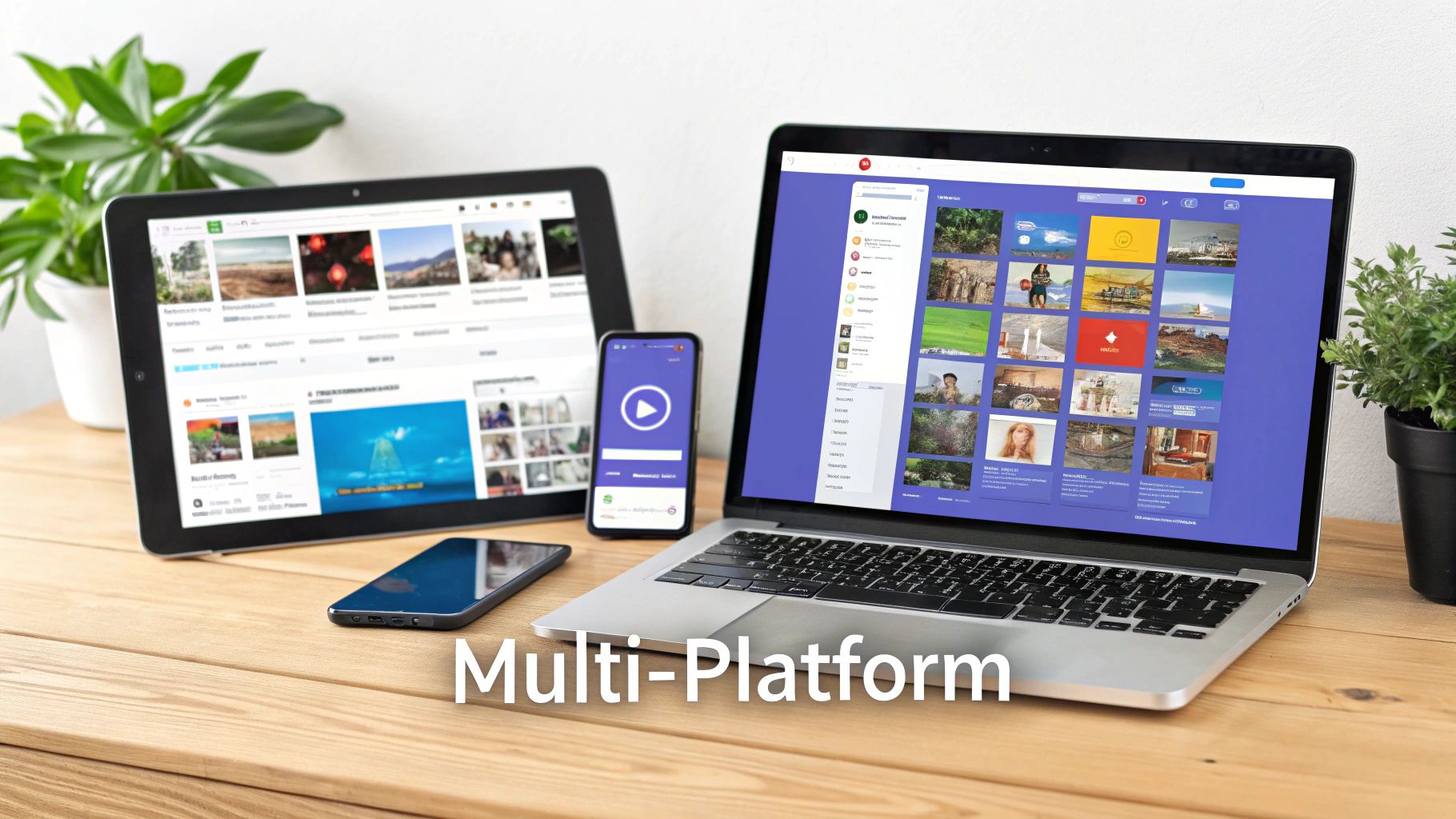
How to Implement Platform-Specific Adaptation
Adapting content effectively requires understanding the nuances of each channel. The goal is to present the same core value in a way that feels built specifically for the platform it's on.
- Study Platform Norms: Deeply analyze what performs best on each channel. Notice the video lengths, caption styles, visual aesthetics, and types of conversations that thrive.
- Maintain Brand Consistency: While the format changes, your brand's core message, tone, and visual identity should remain consistent. Use the same color palette and logo, but apply them to different templates.
- Leverage Native Features: Go beyond the post itself. Use platform-specific features like Instagram Stories polls, LinkedIn articles, or Twitter/X threads to present your adapted content.
- Test and Iterate: Don't assume your first adaptation is perfect. Test different formats on the same platform, such as a video clip versus a text post on LinkedIn, to see what resonates most with your specific audience.
For instance, a single long-form YouTube video can be adapted in multiple ways. The full audio can become a podcast episode. Key visual segments can be edited into vertical, under-60-second Instagram Reels and TikTok videos. A powerful insight from the video can be expanded into a thought-provoking LinkedIn text post, while key statistics can become a visually engaging Twitter/X thread. This method ensures you meet your audience where they are, in the format they prefer.
3. Quote and Snippet Extraction
Quote and snippet extraction is a highly effective method for capturing attention by isolating the most potent and shareable soundbites from your long-form content. This technique involves pulling compelling quotes, powerful statistics, and concise insights from larger pieces like interviews, articles, or webinars and framing them as standalone social media assets. It's a direct way to distill the core value of your content into a format that is quick to consume and easy to share.
This approach works because it leverages the inherent power of impactful statements. A single, well-chosen quote can spark curiosity, convey authority, and generate emotional resonance far more effectively than a lengthy summary. By extracting these gems, you create content that is not only digestible but also highly memorable, making it a cornerstone strategy for repurposing content for social media.

How to Implement Quote and Snippet Extraction
Effective extraction is about more than just copying and pasting; it's about selecting fragments that can stand on their own while prompting interest in the source material.
- Identify High-Impact Moments: Scour your pillar content (podcasts, videos, articles) for statements that are insightful, controversial, inspiring, or data-driven. Look for the "aha!" moments.
- Provide Context and Attribution: Always credit the speaker or source. Briefly explain the context to ensure the quote's meaning is clear and not misinterpreted.
- Create Visually Branded Graphics: Design templates for quote cards that incorporate your brand's colors, fonts, and logo. Consistency helps build brand recognition. For example:
- LinkedIn: Share a powerful quote from a CEO interview as a text post or a clean graphic to start an industry discussion.
- Instagram/Pinterest: Design visually appealing quote cards from podcast transcripts or book excerpts that are highly shareable.
- Twitter/X: Pull a key statistic from a research report and pair it with a simple graphic or emoji to make it stand out in the feed.
A master of this is author and speaker Simon Sinek, whose team expertly pulls short, thought-provoking quotes from his talks and books. These snippets are transformed into branded graphics and videos for social media, each one delivering a standalone piece of wisdom while reinforcing his broader message. This tactic allows you to consistently provide value and drive traffic back to your original content with minimal effort.
4. Behind-the-Scenes Content Creation
This approach cleverly transforms the content creation process itself into compelling social media material. Instead of only showcasing the final product, you pull back the curtain and give your audience an insider’s look at how your content is made. This strategy builds transparency, fosters a deeper connection with your audience, and maximizes the value you get from every single content initiative.
By documenting the journey, you create a secondary layer of content that is authentic, human, and highly engaging. It’s an effective way to generate extra posts without extra ideation, turning the work-in-progress into a valuable asset. This method makes the entire workflow part of your overall content strategy.

How to Implement Behind-the-Scenes Content
Integrating this into your workflow is about capturing the candid moments of creation. The key is to find interesting parts of your process and frame them as standalone stories for your social channels.
- Document the Process: Record snippets of your work. This could be a time-lapse video of a graphic being designed, a quick photo of your research notes, or a screen recording of you editing a podcast.
- Share Learnings and Challenges: Don't just show what you do; explain why you do it. Share a genuine challenge you overcame or an unexpected insight you discovered during research. This adds an educational layer.
- Build Anticipation: Use behind-the-scenes glimpses to tease upcoming pillar content. A short clip from a video shoot or a screenshot of a report's data visualization can build excitement for the final release.
- Platform-Specific Formats:
- Instagram Stories/Reels: Perfect for quick video clips, polls about design choices, or "ask me anything" sessions about your creative process.
- LinkedIn: Share a text post about the strategic thinking behind a piece of content, detailing the research or methodology.
- Twitter/X: Post quick updates, share surprising stats you uncover during research, or ask your audience for input on a headline.
- YouTube: Create longer vlogs that document the entire creation process of a major project, from brainstorming to launch.
Creative professionals like Casey Neistat popularized this by making the process as entertaining as the final product. For brands, it's a powerful tool for repurposing content for social media because it adds authenticity. It shows the effort and expertise that go into your work, building trust and community around your brand.
5. Q&A and FAQ Transformation
The Q&A and FAQ transformation method turns audience curiosity into a reliable content engine. It involves systematically collecting questions, comments, and feedback from your existing content and customer interactions, then converting them into structured, valuable assets for your social media channels. This approach directly addresses your audience's needs, demonstrating that you are listening and responsive.
Think of your comments section, email inbox, and webinar chat logs as a goldmine of content ideas. Instead of letting these valuable inquiries fade away, this strategy gives them new life as engaging social media posts. This method is a powerful way to add a human, conversational element to your brand, transforming passive content consumption into an active, two-way dialogue.
How to Implement Q&A and FAQ Transformation
A successful Q&A strategy requires an organized system for capturing and answering audience questions. The goal is to create content that not only provides a direct answer but also showcases your expertise and reinforces your core message.
- Content Sources: Actively monitor and save questions from blog post comments, YouTube videos, webinar Q&A sessions, customer support tickets, and social media DMs.
- Thematic Grouping: Group similar or related questions together. This allows you to create more comprehensive and authoritative answers that address a broader topic, such as a "Top 5 Questions About X" carousel or video.
- Platform-Specific Formats: Tailor your Q&A content to the strengths of each platform.
- Instagram: Use the Stories "Questions" sticker to solicit new inquiries and share answers. Create a multi-slide carousel post addressing a complex question from a recent webinar.
- TikTok/Reels: Film short, direct-to-camera videos answering a specific question from a YouTube comment. Use the on-screen text to display the original question for context.
- LinkedIn: Turn a frequently asked question from clients into a thoughtful text post or article that provides a detailed, professional answer, sparking industry discussion.
- Blog/Website: Compile the most common questions into a comprehensive FAQ page that can be promoted across social media.
This technique is a cornerstone for many educational creators and business consultants. For example, a business coach can take questions asked during a discovery call and turn them into a LinkedIn post titled "3 Things to Consider Before Hiring a Coach," directly addressing prospect pain points. This form of repurposing content for social media is highly efficient because the topics are pre-validated by your audience's interest.
6. Visual Content Reformatting
Visual content reformatting is a powerful technique for transforming text-heavy or audio-based information into highly digestible and shareable visual assets. This method focuses on translating complex data, key takeaways, and narrative points into formats like infographics, carousels, charts, and branded graphics. It’s about making information more approachable and memorable through the universal language of visual storytelling.
Many audiences, especially on platforms like Instagram and Pinterest, prefer to consume information visually rather than reading long blocks of text. By reformatting your content, you cater directly to this preference, capturing attention that would otherwise be lost. This strategy is essential for repurposing content for social media because it makes your core message more accessible, engaging, and likely to be shared.
How to Implement Visual Content Reformatting
Effective visual reformatting goes beyond simply adding an image; it requires a thoughtful translation of ideas into a visual narrative. The goal is to distill the essence of your content into a compelling visual format that stands on its own.
- Source Material: Start with content rich in data, lists, processes, or strong concepts. This can include research reports, podcast episodes, case studies, or detailed blog posts.
- Extract Key Points: Identify the most impactful statistics, sequential steps, core arguments, or inspiring quotes. Think about what can be visually represented.
- Choose the Right Format: Convert the extracted points into the best visual format for each platform.
- Instagram/LinkedIn Carousels: Transform the key points of a blog post into a step-by-step carousel. This format is excellent for guiding users through a process or telling a story.
- Infographics: Turn a dense research report or a data-heavy article into a single, comprehensive infographic for Pinterest or a blog summary.
- Quote Graphics: Pull powerful statements from a podcast or article and create branded graphics for Instagram Stories, X (formerly Twitter), or Facebook.
- Charts and Graphs: Isolate key statistics and present them as clear, visually appealing charts for LinkedIn posts or presentation slides.
A great example is taking a listicle like "Top 10 Marketing Trends" and creating a ten-slide Instagram carousel. Each slide can visually represent one trend with a title, a brief explanation, and consistent branding. When preparing visuals for professional networks, even small details matter; perfecting your LinkedIn profile picture, for instance, ensures your brand's visual identity remains polished and credible alongside your content. This strategic approach to visual translation is a cornerstone of modern social media marketing. To ensure your visuals are perfectly sized for different platforms, you can learn more about how to optimize Pinterest images for maximum engagement.
7. Teaser and Preview Strategy
The teaser and preview strategy transforms your social media channels into a powerful promotional engine, building anticipation and driving traffic directly to your core content assets. This method involves sharing carefully selected, compelling snippets or highlights from larger pieces of content before or during their launch. It’s about giving your audience just enough to pique their interest, making them eager to consume the full piece.
Think of it like a movie trailer for your blog post, podcast, or webinar. You aren't giving away the entire plot; you're showcasing the most exciting moments, intriguing questions, and valuable insights to create a "fear of missing out" (FOMO). This approach effectively turns your social media followers into an engaged, ready-to-convert audience for your main content hubs.
How to Implement a Teaser and Preview Strategy
A successful teaser campaign requires strategic planning and a deep understanding of what makes your audience click. The goal is to create a compelling hook that promises significant value in the full content piece.
- Pillar Content: Identify an upcoming or existing high-value asset, such as a new YouTube video, a detailed case study, a podcast episode, or a new product launch.
- Extract Intriguing Snippets: Pull out the most captivating elements. This could be a controversial statement, a surprising statistic, a key cliffhanger moment, or a powerful quote.
- Create Platform-Specific Teasers: Adapt these snippets into formats designed to generate curiosity on each social channel.
- Instagram/Facebook Stories: Use the countdown sticker for an upcoming blog post or webinar launch. Share a short video clip from an interview with a provocative question.
- Twitter/X: Post a thought-provoking quote or a surprising data point from a report and ask your audience for their opinion, promising the full context in the linked content.
- LinkedIn: Share a professional insight or a key learning from a case study and announce that the full breakdown will be published tomorrow.
- YouTube/TikTok: Create a short, fast-paced "trailer" video that combines the most dynamic moments from a longer YouTube video to drive viewers to the full-length version.
A great example is how podcasters often share a 30-60 second audiogram on social media, featuring the most insightful or humorous moment from an upcoming episode. This is a perfect execution of repurposing content for social media to build an audience. By creating this anticipation, you not only boost immediate traffic but also significantly increase brand awareness on social media over time.
7-Method Content Repurposing Comparison
| Strategy | Implementation Complexity 🔄 | Resource Requirements ⚡ | Expected Outcomes 📊 | Ideal Use Cases 💡 | Key Advantages ⭐ |
|---|---|---|---|---|---|
| Atomization Strategy | Medium-high: planning intensive | Moderate: initial setup time, content mapping | High ROI, increased content reach | Repurposing long-form content across multiple platforms | Maximizes content ROI; consistent messaging; workload reduction |
| Platform-Specific Format Adaptation | High: requires deep platform knowledge | High: design and editing tools; algorithm understanding | Increased engagement and reach | Tailoring content to platform specifics | Maximizes engagement; improves algorithm performance |
| Quote and Snippet Extraction | Low-medium: selective extraction | Moderate: design skills for visuals | High engagement; shareable content | Highlighting impactful insights and statistics | Drives traffic; builds thought leadership |
| Behind-the-Scenes Content Creation | Low-medium: requires transparency | Low: utilizes existing process documentation | Strong audience connection; increases volume | Showcasing content creation process and stories | Builds authenticity; humanizes brand |
| Q&A and FAQ Transformation | Medium: requires audience input | Low-moderate: content structuring and updates | High engagement; expertise establishment | Addressing audience questions and common concerns | Directly addresses audience; evergreen content |
| Visual Content Reformatting | Medium-high: design focused | High: design tools and skills | Increased engagement; accessibility | Converting complex data into visual formats | Enhances shareability; appeals to visual learners |
| Teaser and Preview Strategy | Medium: timing and balance critical | Low-moderate: content snippets and visuals | Increased anticipation and traffic | Promoting upcoming content releases | Builds anticipation; drives traffic; creates urgency |
Streamline Your Repurposing Workflow and Amplify Your Reach
The journey through the art of repurposing content for social media reveals a powerful truth: your best content deserves more than a single moment in the spotlight. By moving beyond a "one-and-done" publishing mindset, you unlock immense potential hiding within your existing assets. The strategies we've explored, from atomizing pillar posts into bite-sized thought leadership to reformatting webinars into engaging video clips, are not just about saving time. They are about building a smarter, more resilient content engine.
Mastering these techniques transforms your content from a static library into a dynamic ecosystem. Each piece works in concert with the others, creating multiple entry points for your audience and reinforcing your core message across every platform. This approach ensures your valuable insights reach their maximum potential audience, whether they prefer a quick Twitter thread, an in-depth LinkedIn carousel, or a behind-the-scenes Instagram Story.
Key Takeaways for a Sustainable Content Strategy
To truly make these concepts work for you, focus on these core principles:
- Think in Systems, Not Silos: View every piece of long-form content as the cornerstone of a future micro-content campaign. Before you even hit publish on a blog post or video, start brainstorming how it can be atomized, quoted, and visually reimagined.
- Prioritize Platform-Native Formats: The most successful repurposing respects the user's context. A direct copy-paste from a blog to a tweet will always underperform. Adapt your message to the unique language and format of each platform, whether that means turning data points into an infographic for Pinterest or a key statistic into a bold, text-based Reel.
- Build a Repurposing Toolkit: Success relies on both strategy and execution. Identify the tools that will eliminate friction from your workflow. This includes graphic design templates in Canva, a reliable video editor for creating short clips, and, most importantly, a central hub to manage the entire process.
Your Actionable Next Steps
Effective content repurposing is not a passive activity; it requires a proactive, organized approach. The most significant barrier to consistency is often logistical complexity. Managing dozens of repurposed assets for multiple platforms across a content calendar can quickly become overwhelming, leading to missed opportunities and creative burnout.
This is where integrating a powerful management tool becomes a strategic imperative. By centralizing your content library, scheduling your posts, and analyzing performance data, you move from a chaotic, reactive process to a streamlined, strategic operation. This is the key to making repurposing a sustainable and scalable part of your marketing efforts, rather than just another task on your to-do list. Embracing this disciplined approach to repurposing content for social media is what separates brands with a fleeting presence from those with lasting authority and impact.
Ready to put these strategies into action with a tool built for efficiency? PostSyncer provides a centralized dashboard to plan, schedule, and analyze all your repurposed content. Stop juggling spreadsheets and scattered files, and start building a powerful content engine today by visiting PostSyncer.
